National Historic Landmarks in Montana
Ancient brush strokes on cave walls near Billings, glorious rustic lodges in Glacier National Park, and the log homestead of a venerable Crow chief are among several dozen extraordinary places that help define and interpret Montana’s past. East to west and in between, Montana’s irreplaceable National Historic Landmarks (NHLs) enhance the western experience.
The Secretary of the Interior bestows landmark distinction upon heritage sites, buildings, and places that illustrate our nation’s past. The National Park Service administers the NHL program to assist federal, state, and private stewards in the preservation of these significant links to our heritage. Montana’s NHLs interpret prehistory, Native American culture, cattle ranching, mining, early tourism, and more. Some attract tourists from every corner of the globe, and others—though every bit as spectacular—are not so well known.
A number of Montana’s NHL places are pivotal to the Lewis and Clark Expedition, underscoring the extensive travels in Montana where the Corps spent more time exploring than any other place. This summer, the end of the Lewis and Clark Bicentennial, is a perfect time to plan your own journey of discovery. Follow the NHLs that trace the trail of the explorers and discover some others along the way.
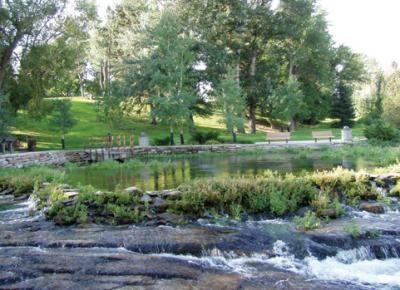
You might start with the Great Falls Portage NHL where two hundred years ago the men of the Corps dragged crude wagons filled with supplies eighteen grueling miles across gullies and around ravines skirting the spectacular falls. Grizzly bears, prickly pear, and mosquitoes menaced them under a scorching summer sun. The town of Great Falls grew up around the area where water once tumbled over five cascades. Four of them have long since been harnessed for hydroelectric power, but segments of the portage route remain nearly pristine. At Giant Springs State Park, part of the landmark, the freshwater springs are among the largest in the world, daily pumping out 156 million gallons of clear, aquamarine water. In this primeval setting, Meriwether Lewis first noted the yellow-breasted Western Meadowlark that became Montana’s state bird. Near the park’s entrance, the US Forest Service operates the Lewis and Clark Historic Trail Interpretive Center, an essential stop.
Travel south 165 miles to the Three Forks of the Missouri NHL and the Missouri Headwaters State Park. Native people already had names for what Lewis and Clark called the Gallatin, Jefferson and Madison rivers that come together there. “The Place of Many Rivers” was a crossroads known to generations of Crow, Salish, Blackfeet, Nez Perce, Shoshone and other tribes. A short distance downstream, early people quarried stone to make tools. Pacific shell and obsidian scattered over the area are evidence of widespread precontact trade. The 560-acre park includes seasonal interpreters and hiking trails offering timeless adventure. The wet meadowlands along the riverbanks are home to sandhill cranes and other wildlife.
Head northwest to Missoula and up to Traveler’s Rest near Lolo where archaeologists have found the only documented Lewis and Clark campsite. Several hearths yielded traces of lead used in making musket balls. A vapor mercury analyzer detected significant levels of mercury in the soil at the latrine site. According to the Journals, three men were ill while the Corps camped at Traveler’s Rest, and liberally dosed themselves with Dr. Rush’s Pills. These strong purgatives, known as Rush’s Thunderbolts, contained 60% mercury, an element that does not decompose. The men’s discomfort, however, allowed positive detection of the site prompting the relocation of the original nearby landmark to this site. Traveler’s Rest State Park is the least developed but perhaps Montana’s most significant Lewis and Clark landmark. Seasonal interpreters give visitors a feel for the life of an explorer two hundred years ago.
From Traveler’s Rest, you can follow parts of the Lolo Trail NHL along Highway 12. The Corps took this treacherous Nez Perce route along ridge tops through the thick, tangled timberland of the Bitterroot Mountains and over Lolo Pass. Fallen timber, snow, ice, and steep ridges made for a wretched, dangerous passage. The horses slid down the slopes and the men were sick with dysentery, hungry, and wet when they finally reached a Nez Perce village at Weippe Prairie, Idaho. On the return trip from the Pacific, despite seven feet of snow, the men again reached Traveler’s Rest on June 30, 1806.
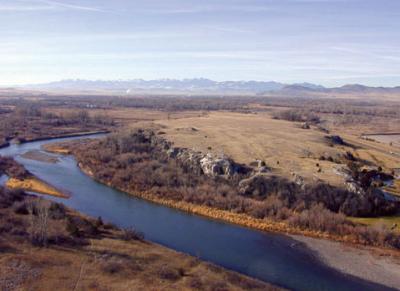
On a sandstone pillar one hundred twenty feet above the plain, Captain William Clark added his signature and the date, July 25, 1806, to native pictographs. He named the landmark “Pompy’s Tower” after Sacajawea’s infant son, Baptiste, whom Clark had nicknamed Pomp. Journal editors later renamed it Pompey’s Pillar. Other travelers, including a Smithsonian expedition in 1875 and soldiers under Colonel John Gibbon in 1876, left their names on Pompey’s Pillar. Twenty-five miles east of Billings, the Bureau of Land Management manages Pompey’s Pillar NHL and National Monument.
A journey of discovery across Montana might include these important Lewis and Clark places along with other NHLs of equal significance. Pictograph Cave NHL, for example, is an archaeological site seven miles southeast of Billings. Wind and water carved three main caves where nomadic hunters found shelter as long ago as 2,000 years. Ancient artists left cultural clues on the cave walls in red, white, and black pigments. The cave art, still faintly discernible, is a delicate and endangered resource. Pictograph Cave State Park welcomes visitors from mid-April to mid-October. Be sure to bring binoculars for better viewing.
Chief Plenty Coups Homestead NHL on the Crow Reservation west of Pryor was the home of the influential Crow chief, renowned as a negotiator and statesman. As a youngster, Plenty Coups had a dream foretelling the demise of the buffalo, central to the culture of the Plains Indians. He became a model for his people and a bridge between the old ways and the new. Plenty Coups built his home in 1884 and learned farming as an example to his people. Toward the end of his life, Plenty Coups and his wife set aside the present forty-acre state park for both Crow and white to enjoy jointly. When the great chief died in 1932, he was so venerated that the Crow Nation never named a successor. Plenty Coups’ landmark homestead and a museum are open year round.
Sixteen miles south of Chinook along the windswept Montana hi-line, hikers can follow a self-guided trail through an undeveloped landscape. In that area on September 30, 1877, General Nelson Miles attacked the camp where Chief Joseph and more than four hundred Nez Perce had stopped to rest. Fleeing their Idaho homeland with soldiers in pursuit, the Nez Perce were just fifty miles from their destination at the Canadian border. After a six-day siege, Chief Joseph surrendered. Henceforth, his people lived miserably as displaced persons in Kansas and Oklahoma Territory where hundreds died of malnutrition and starvation. Although Chief Joseph’s famous statement, “I will fight no more forever,” is likely fiction, his surrender is one of history’s most poignant and tragic events. The Chief Joseph Battleground of Bear’s Paw NHL is a National Park.
Rosebud Battlefield State Park, twenty-five miles east of Crow Agency near the Wyoming border, is a new NHL awaiting final confirmation. The park is the site of one of the nation’s largest Indian battles. Sioux and Cheyenne defeated cavalry and infantry under General George Crook. There were 2500 participants in this prelude to the stunning defeat of General George Custer at Little Bighorn eight days later. The site is rich in archaeological features including a buffalo jump and offers panoramic views of the Bighorn Mountains.

The world’s innermost port lies at the last navigable point on the Missouri River, a charming little town once dubbed the “Chicago of the Plains.” Fort Benton NHL began as a fur trading post in Blackfeet country. With the gold rush it became a transportation center where everything from nails and shoes to crystal chandeliers and grand pianos crossed its docks en route to the gold fields. The advent of the railroad ended its glory, but the restored Grand Union Hotel, riverfront, and historic fort are worth the trip.
Three NHLs recall the importance of mining to Montana’s early settlement. Bannack and Virginia City, both gold rush boomtowns, and the great urban center of Butte, are sites not to be missed. Bannack Historic District NHL, now a state park, sprang to life with the discovery of gold at Grasshopper Creek in 1862. Briefly, it was the first territorial capital with a population of 3,000. Today it is a ghost town whose empty buildings, preserved in arrested decay, include the 1875 Beaverhead County Courthouse (later converted to the Meade Hotel), the 1860s Skinner Saloon, the Methodist Church, and others spanning the town’s lifetime into the twentieth century. Stroll the wooden sidewalks, visit the gallows where Sherriff Henry Plummer met his fate, and listen to the wind. Doors creak and empty rooms beckon visitors to explore Bannack’s secrets.
Virginia City, on the other hand, is very much a living town with more gold rush era buildings than anywhere in the West. Virginia City became Montana’s first population hub after prospectors made a spectacular gold strike at Alder Gulch in 1863. As the territorial capital from 1865 to 1875, its history is rich with tales of vigilantes and territorial politics. Placering, hydraulicking, hard rock mining, and dredging operations left visible scars upon the landscape. Under state and private ownership, Virginia City Historic District NHL is a legacy of the gold mining industry and the spirit of the West.
Gold and silver mining spurred the settlement of Butte, but it was copper, critical to the electrification of America, that gave it a forty-one percent share of the world’s copper market and a population that peaked at more than 100,000. Workers came to Butte from every culture and ethnic group. Nicknamed the “Gibraltar of Unionism” for its labor history, Butte made copper kings and company officials wealthy. They left magnificent homes to ornament the streets while the headframes that carried men underground still loom stark across the landscape. The Butte Historic District NHL is the largest landmark in the West and a labor icon. Its extension, the Butte-Anaconda Heritage Corridor, is Montana’s newest landmark.

If the cowboy life appeals, visit the Grant-Kohrs Ranch NHL at Deer Lodge and learn how a nineteenth century cattle outfit operates. Johnny Grant brought the first longhorns into the Deer Lodge valley in 1859 and built one of the first frame homes in Montana in 1862. He sold the property to Conrad Kohrs in 1866. Kohrs pioneered the cattle ranching business from the ground up, annually shipping eight to ten thousand head to market. Ownership of the working ranch remained in the Kohrs family until the 1970s. The National Park Service has operated the ranch since 1972. The 90-building complex and the fully-furnished home are open daily.
Montana is known for spectacular scenery, but nothing compares to the breathtaking views along the fifty-two mile stretch of Going-to-the-Sun–Road NHL. This feat of civil engineering, completed in 1932, is a two-lane highway through Glacier National Park showcasing glacial lakes, alpine tundra, and cedar forests.
The Great Northern Railway Buildings NHL within Glacier National Park includes the sprawling Many Glacier Hotel and several smaller chalets. Great Northern Railway chairman of the board Louis Hill dubbed the park’s rugged mountains “America’s Alps” and built his tourist accommodations blending the Swiss Chalet style with the rustic frontier. Many Glacier Hotel, built between 1914 and 1917, is the largest with over 200 guest rooms. Another NHL in the park is Lake McDonald Lodge, financed by a private developer to rival Hill’s hotels. A stay in one of these unique historic hostelries is a great way to enjoy America’s Alps.
Montana’s NHLs offer sweeping vistas, urban streetscapes, and ancient pathways that make tangible connections to the past. Reach back in time, hold hands with history, and experience Montana in a journey to its National Historic Landmarks.
~ Ellen Baumler is the interpretive historian at the Montana Historical Society in Helena. Although best known for her tales of Montana’s haunted places, collected in Spirit Tailings and Beyond Spirit Tailings, she is also a teacher, lecturer, and popular tour guide of Helena’s historic landmarks. Ellen is co-author with Dave Shors of Lost Places, Hidden Treasures, a photographic history of Helena, Montana.




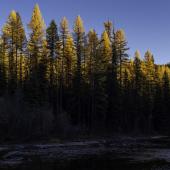
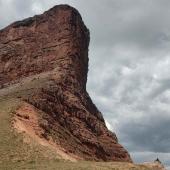




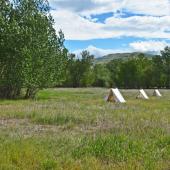
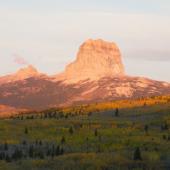
Leave a Comment Here